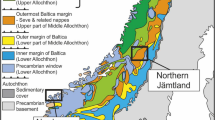Abstract
Ion-microprobe analysis of zircons from an andalusite-bearing orthogneiss within the major Alpujárride nappe complex in the central part of the Betic Cordilleras has yielded a Hercynian age of 285 ± 5 (2σ) Ma for euhedral rims, interpreted as the magmatic age of the andalusite-bearing biotite granite parent rock for the gneisses. Zircon age zoning systematics suggest a Paleozoic sedimentation age for the parent material for the anatectic source rock. Zircon cores represent several groups of ages: (1) Archean, c. 2.7 Ga; (2) Early Proterozoic, 2.2–2.0 Ga; (3) Middle Proterozoic, 1.1–0.9 Ga; (4) Pan-African, 0.8–0.5 Ga; including a well-defined event at 612 ± 13 (2σ) Ma. Paragenetic and textural relations indicate that gneissification took place during a high-P (12–13 kbar) low-T (450–500 °C) collisional event during which the primary Alpine nappe pile was produced. The second and final Alpine tectono-metamorphic event led to reorganization of the primary nappe pile by extensional tetonics with coeval very fast rock uplift and cooling (from c. 8? to c. 1 kbar and c. 600 to 100 °C within the period 19.5–18.5 Ma). The fast uplift/cooling stage was triggered by slab break-off which is thought to have induced diapiric underplating by high-T asthenospheric material. This may have heated the collisional wedge, causing thermal weakening which might have advanced the late stage fast uplift/cooling. The Alpine events did not leave a zircon crystallization record. The inherited, Archean–Pan-African zircon age pattern corresponds to that established for the Hercynian basement in central and southern Europe which is considered as reworked Gondwana crust. Deeper levels of core complexes within the Betic-Rif belt thus belong to the pre-Triassic basement of the Tethyan realm (Betic-Ligurian lithosphere) and represent reworked material ultimately derived from Archean and Proterozoic rock complexes from the Gondwana crustal domain. This study implies that thermobarometry of rock complexes which went through several phases of tectono-metamorphic reworking may render ambiguous results if based upon field observations and petrography alone. Zircon ion-microprobe dating may provide additional constraints required to arrive at a feasible tectono-metamorphic history, that is P-T-t trajectory, for such rock complexes.
Similar content being viewed by others
Author information
Authors and Affiliations
Additional information
Received: 16 February 1998 / Accepted: 24 August 1998
Rights and permissions
About this article
Cite this article
Zeck, H., Whitehouse, M. Hercynian, Pan-African, Proterozoic and Archean ion-microprobe zircon ages for a Betic-Rif core complex, Alpine belt, W Mediterranean – consequences for its P-T-t path. Contrib Mineral Petrol 134, 134–149 (1999). https://doi.org/10.1007/s004100050474
Published:
Issue Date:
DOI: https://doi.org/10.1007/s004100050474




